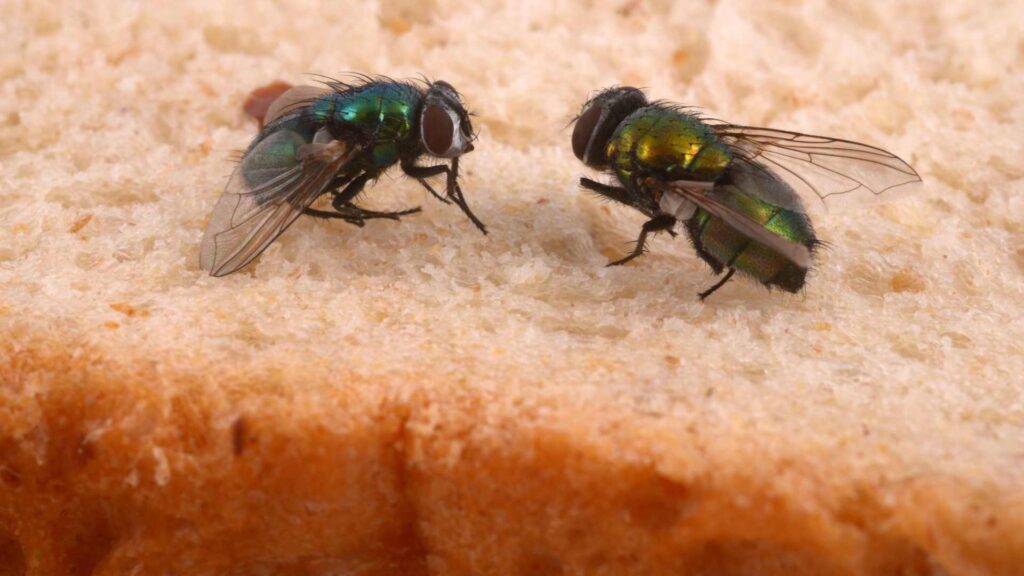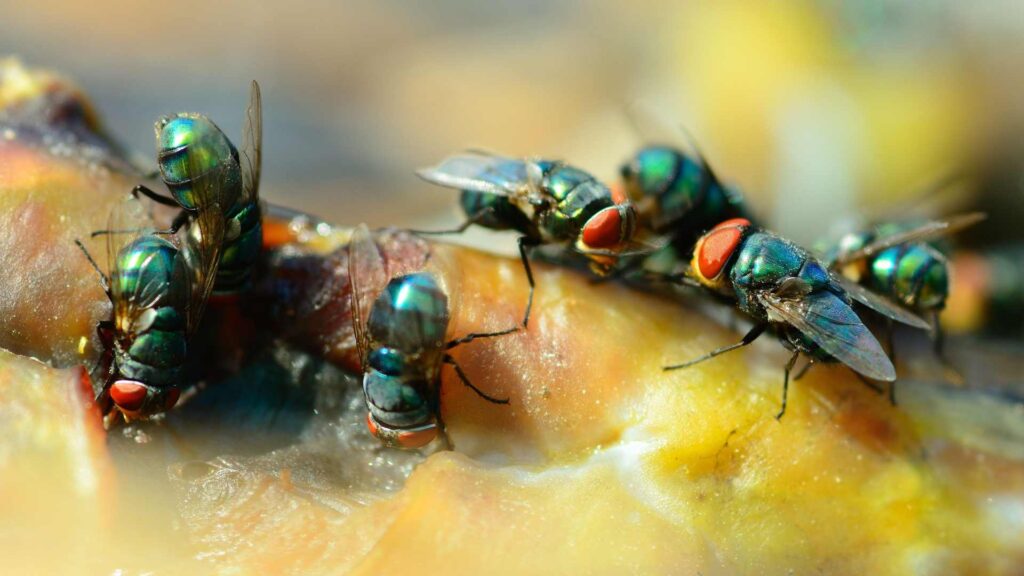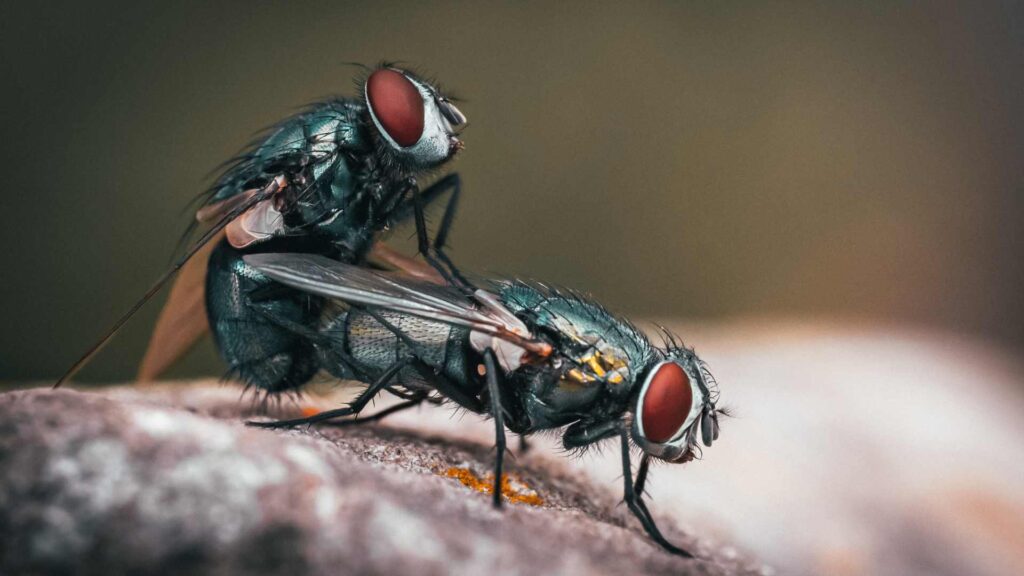If you’ve noticed the unsettling presence of blue flies in your house, you’re not alone. These pests, often mistaken for common houseflies, can quickly become a nuisance, buzzing around your home and potentially posing health risks.
But what exactly are these blue flies, and why have they chosen your house as their new hangout? In this article, we’ll explore the reasons behind their appearance, the dangers they might bring, and, most importantly, how to get rid of them for good.
Whether you’re dealing with a sudden infestation or looking to prevent one, understanding these pests is the first step toward reclaiming your home.
Identifying Blue Flies in Your House
Blue flies, while not as common as houseflies, can be a nuisance and potential health hazard. Here’s how to spot them:
Common Species of Blue Flies Found Indoors
- Blowflies: These are the most common type of blue fly found indoors. They have a metallic blue or green sheen and are often found around decaying matter.
- Bottle flies: These flies are slightly larger than blowflies and have a distinctive checkerboard pattern on their abdomen. They are often attracted to garbage and decaying food.
- Flesh flies: These flies are larger than blowflies and bottle flies and have a reddish-brown thorax. They are attracted to decaying meat and can be found around garbage and pet waste.
How to Distinguish Blue Flies from Other Flies
- Color: Blue flies are typically blue or green, while other flies may be brown, gray, or black.
- Size: Blue flies are generally larger than houseflies and other common household flies.
- Behavior: Blue flies are often found around decaying matter, while other flies may be attracted to food or light.
Visual Characteristics and Behavior of Blue Flies
- Metallic sheen: Blue flies have a distinctive metallic sheen on their bodies.
- Large size: They are larger than most other household flies.
- Strong odor: They are often attracted to strong odors, such as decaying matter.
- Rapid flight: Blue flies are quick and agile fliers.
Why Are Blue Flies Attracted to Your Home?
Blue flies are attracted to indoor environments for several reasons:
- Food sources: Blue flies are attracted to decaying food and garbage.
- Pet waste: Pet waste can be a major source of attraction for blue flies.
- Open windows and doors: Blue flies can enter homes through open windows and doors.
- Poor sanitation: Unclean environments can provide breeding grounds for blue flies.
Common Sources of Blue Fly Infestations
- Garbage cans: Garbage cans that are not properly sealed can attract blue flies.
- Pet waste: Pet waste that is not cleaned up regularly can also attract blue flies.
- Decaying food: Leftover food that is not stored properly can attract blue flies.
- Sewer lines: Sewer lines that are damaged or leaking can be a source of blue fly infestations.
Seasonal Patterns and Why You Might Notice Them More at Certain Times
- Warm weather: Blue flies are more active during warm weather months.
- Food availability: The availability of food sources, such as decaying matter, can influence the number of blue flies present.
- Breeding conditions: Suitable breeding conditions, such as warm, moist environments, can contribute to increased blue fly populations.
The Impact of Blue Flies on Health and Hygiene
Blue flies can pose a significant health risk if not addressed promptly.
Potential Health Risks Associated with Blue Flies
- Disease transmission: Blue flies can transmit diseases such as typhoid fever, cholera, and dysentery by carrying bacteria on their feet and bodies.
- Food contamination: Blue flies can contaminate food by landing on it and transferring bacteria.
- Nuisance pests: Blue flies can be a nuisance and can make it difficult to enjoy your home.
How Blue Flies Affect Indoor Air Quality and Overall Cleanliness
- Contamination of surfaces: Blue flies can contaminate surfaces with bacteria and other pathogens.
- Odor issues: Decaying matter can cause unpleasant odors in the home.
- Psychological impact: The presence of blue flies can cause stress and anxiety.
How to Get Rid of Blue Flies in Your House
If you have a blue fly infestation, there are several steps you can take to eliminate it.
Immediate Steps to Take When You Notice Blue Flies
- Identify the source: Determine where the blue flies are coming from.
- Seal entry points: Seal any cracks or openings in your home that blue flies can use to enter.
- Clean and sanitize affected areas: Thoroughly clean and sanitize areas where blue flies have been observed.
Removing Attractants and Entry Points
- Dispose of garbage properly: Seal garbage cans tightly and dispose of garbage regularly.
- Clean up pet waste: Clean up pet waste promptly and dispose of it properly.
- Store food properly: Store food in airtight containers.
- Repair leaks and damage: Repair any leaks or damage that could be attracting blue flies.
Long-Term Strategies for Prevention
- Regular cleaning: Keep your home clean and free of clutter.
- Sanitation practices: Practice good sanitation habits, such as washing hands frequently and disinfecting surfaces.
- Pet care: Ensure that your pets are clean and well-groomed.
- Outdoor maintenance: Keep your yard clean and free of debris.
Natural Remedies and DIY Approaches
- Fly traps: Use sticky fly traps or homemade fly traps to capture blue flies.
- Essential oils: Some essential oils, such as lavender and eucalyptus, can repel blue flies.
- Diatomaceous earth: Sprinkle diatomaceous earth in areas where blue flies are present.
Commercial Insecticides for Blue Flies
To effectively deal with a blue fly infestation, consider using commercial insecticides such as:
- Raid Multi Insect Killer: A popular and versatile option that kills blue flies on contact.
- Ortho Home Defense Insect Killer: Provides long-lasting protection by creating a barrier around entry points.
- Hot Shot Flying Insect Killer: Targets flying insects specifically, including blue flies, and offers quick knockdown.
- TERRO Fly Magnet: A trap-based solution that attracts and kills blue flies without the use of harsh chemicals.
Common Mistakes to Avoid When Dealing with Blue Flies
- Ignoring the problem: The longer you wait to address a blue fly infestation, the worse it can become.
- Using ineffective methods: Some home remedies may not be effective against blue flies.
- Failing to address the root cause: Simply eliminating the blue flies may not be enough; you also need to address the underlying cause of the infestation.
Choosing the Right Pest Control Method
When dealing with a blue fly infestation, it’s important to choose the right
flies pest control method.
Comparing Chemical versus Natural Methods
- Chemical methods: Chemical insecticides can be effective against blue flies, but they can also be harmful to humans and pets.
- Natural methods: Natural methods, such as traps and essential oils, are generally safer but may not be as effective as chemical methods.
Effectiveness of Various Traps and Deterrents
- Sticky fly traps: Sticky fly traps can be effective at capturing blue flies.
- Fly swatters: Fly swatters can be used to manually eliminate blue flies.
- Essential oils: Some essential oils, such as lavender and eucalyptus, can repel blue flies.
When to Call in a Professional Exterminator
- Severe infestations: If you have a severe infestation or if you are unable to control the problem on your own, it’s best to call in a professional exterminator.
- Health concerns: If you have health concerns related to the blue flies, it’s important to seek professional help.
Preventing Future Infestations of Blue Flies
By taking preventative measures, you can help to keep your home free of blue flies.
Best Practices for Keeping Blue Flies Out of Your Home
- Regular cleaning: Keep your home clean and free of clutter.
- Sanitation practices: Practice good sanitation habits, such as washing hands frequently and disinfecting surfaces.
- Pet care: Ensure that your pets are clean and well-groomed.
- Outdoor maintenance: Keep your yard clean and free of debris.
Regular Maintenance Tips for Cleanliness and Hygiene
- Garbage disposal: Dispose of garbage regularly and seal garbage cans tightly.
- Pet waste removal: Clean up pet waste promptly and dispose of it properly.
- Food storage: Store food in airtight containers.
- Dishwashing: Wash dishes promptly after use.
How to Properly Store Food and Waste
- Refrigeration: Store perishable foods in the refrigerator.
- Sealing containers: Seal food containers tightly.
- Garbage disposal: Dispose of garbage regularly and seal garbage cans tightly.
Seasonal Checks and Preventative Measures
- Window and door screens: Ensure that your window and door screens are in good condition.
- Outdoor maintenance: Keep your yard clean and free of debris.
- Regular inspections: Inspect your home for signs of blue fly activity.
Addressing Structural Issues
Structural issues can contribute to blue fly infestations.
Inspecting and Sealing Potential Entry Points
- Cracks and crevices: Inspect your home for cracks and crevices that blue flies can use to enter.
- Sealing materials: Seal any cracks or crevices with caulk or silicone sealant.
Importance of Maintaining Good Ventilation and Moisture Control
- Ventilation: Ensure that your home has adequate ventilation.
- Moisture control: Address any moisture problems in your home, such as leaks or mold.
Conclusion: Keeping Your Home Free of Blue Flies
By understanding the factors that attract blue flies and taking appropriate measures, you can effectively prevent and eliminate infestations.
Recap of Key Points on Identification, Removal, and Prevention
- Identification: Learn to recognize blue flies and their common hiding places.
- Removal: Use a combination of cleaning, sanitation, and pest control methods to eliminate blue flies.
- Prevention: Take preventative measures to keep blue flies out of your home.
Final Thoughts on Maintaining a Fly-Free Home Environment
- Proactive approach: Be proactive in your efforts to prevent blue fly infestations.
- Regular maintenance: Conduct regular inspections and maintenance to identify and address potential problems.
- Professional help: Don’t hesitate to seek professional help if you are unable to control a blue fly infestation on your own.


